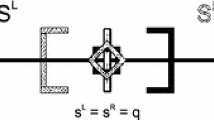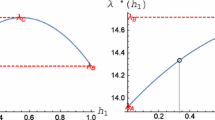Abstract
Guo and Lai (Ann Reg Sci 52(1):309–324, 2014) argue that, under quadratic transport costs, when two offline firms compete with one online firm, the two offline firms locate in such a way that they occupy unconnected regions in the market. However, we offer a counterexample to show that their provided condition is not sufficient to support existence of subgame perfect equilibria, because location deviations to different market structures are not taken into account.

Similar content being viewed by others
Notes
In Fig. 1 (market structures A and B), we consider \( p_{1} = p_{2} \) as the two traditional retailers are symmetric.
Note that this problem does not arise under market structure A, because in this case the locations of the traditional retailers are not relevant for the equilibrium prices.
The locations of the traditional firms are irrelevant for the equilibrium profits in market structure A. However, the location of Firm 2 is relevant in the case of a deviation of Firm 1 from the putative equilibrium.
Note that \( 1 > n_{2}^{R} > n_{12} > n_{1}^{L} > 0 \) implies that it cannot be \( 1 > n_{2}^{R} > n_{2}^{L} > n_{1}^{R} > n_{1}^{L} > 0 \).
All numerical examples we simulated through the software Mathematica confirm that a deviation from market structure A to induce market structure B is always profitable. Instead, Guo and Lai (2014) only consider one possible deviation, with Firm 1 locating at the left endpoint (\( x_{1} = 0 \)), and they show that this particular deviation is not profitable.
Indeed, when there is no online competition, the profits of each traditional retailer are larger.
References
Aguirregabiria V, Vicentini G (2016) Dynamic spatial competition between multi-store retailers. J Indust Econ 64(4):710–754
Brown JR, Goolsbee A (2002) Does the internet make markets more competitive? Evidence from the life insurance industry. J Polit Econ 110(3):481–507
Brynjolfsson E, Smith MD (2000) Frictionless commerce? A comparison of internet and conventional retailers. Manag Sci 46(4):563–585
Chevalier J, Goolsbee A (2003) Measuring prices and price competition online: Amazon and Barnes and Noble. Quant Mark Econ 1(2):203–222
Chu C-P, Guo W-C, Lai F-C (2012) On the competition between an online bookstore and a physical bookstore. Netnomics 13(1):141–154
D’Aspremont C, Gabszewicz JJ, Thisse J-F (1979) On Hotelling’s “stability in competition”. Econometrica 47(5):1145–1150
Dixon T, Marston A (2002) U.K. retail real estate and the effects of online shopping. J Urban Technol 9(3):19–47
Foncel J, Guyot M, Jouneau-Sion F (2011) The ship around the corner in the internet age. Rech Écon de Louvain 77(2):47–85
Guo W-C, Lai F-C (2014) Spatial competition with quadratic transport costs and one online firm. Ann Reg Sci 52(1):309–324
Guo W-C, Lai F-C (2017) Prices, locations and welfare when an online retailer competes with heterogeneous brick-and-mortar retailers. J Indust Econ 65(2):439–468
Hotelling H (1929) Stability in competition. Econ J 39(153):41–57
Kotkin J (2001) The new geography: How the digital revolution is reshaping the American landscape. Random House, New York
Li J (2010) Choosing the right battles: how independent bookshops in Sydney, Australia compete with chains and online retailers. Aust Geogr 41(2):247–262
Author information
Authors and Affiliations
Corresponding author
Additional information
Publisher's Note
Springer Nature remains neutral with regard to jurisdictional claims in published maps and institutional affiliations.
Rights and permissions
About this article
Cite this article
Colombo, S., Hou, Z. On spatial competition with quadratic transport costs and one online firm. Ann Reg Sci 63, 241–247 (2019). https://doi.org/10.1007/s00168-019-00934-x
Received:
Accepted:
Published:
Issue Date:
DOI: https://doi.org/10.1007/s00168-019-00934-x




